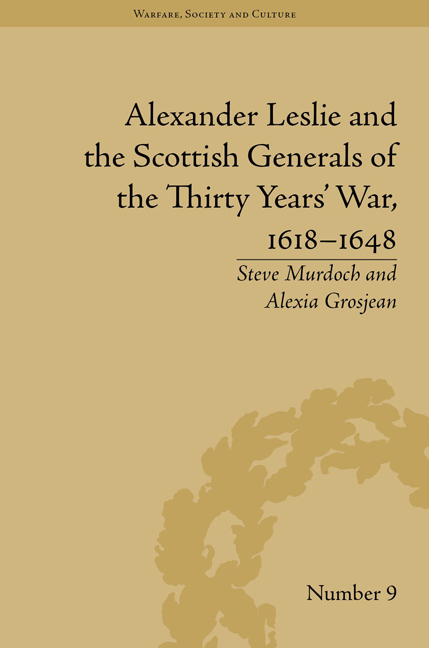Book contents
- Frontmatter
- CONTENTS
- Dedication
- Acknowledgements
- Abbreviations
- Stylistic Conventions
- Introduction
- 1 Scotland's Indigenous Military Cultures
- 2 The Scottish Military Diaspora
- 3 The Thirty Years' War Campaigns: Stralsund to Prague, 1628–35
- 4 Alexander Leslie and the Army of the Weser, 1635–9
- 5 The Home Front: Leslie, Ruthven and the Bishops' Wars, 1638–41
- 6 The Scottish ‘Veteran Generals’ in England, 1642–7
- 7 Going Full Circle: The New Scottish Command in Europe, 1639–48
- Conclusion
- Appendix
- Notes
- Works Cited
- Index
2 - The Scottish Military Diaspora
- Frontmatter
- CONTENTS
- Dedication
- Acknowledgements
- Abbreviations
- Stylistic Conventions
- Introduction
- 1 Scotland's Indigenous Military Cultures
- 2 The Scottish Military Diaspora
- 3 The Thirty Years' War Campaigns: Stralsund to Prague, 1628–35
- 4 Alexander Leslie and the Army of the Weser, 1635–9
- 5 The Home Front: Leslie, Ruthven and the Bishops' Wars, 1638–41
- 6 The Scottish ‘Veteran Generals’ in England, 1642–7
- 7 Going Full Circle: The New Scottish Command in Europe, 1639–48
- Conclusion
- Appendix
- Notes
- Works Cited
- Index
Summary
Alexander Leslie [joined Gustav II Adolf's army] possessed of nothing but his sword, his bastardy – and his genius
As the last chapter demonstrated, late sixteenth-century Scotland was rich in manpower but lacked a standing army. Nevertheless, it was a nation with a history stretching back to the Middle Ages of raising expeditionary forces for the benefit of allies. A systematic survey of the more important of these expeditions dating to Alexander Leslie's formative years illustrates clearly the way in which he and his fellow generals of the Thirty Years' War honed their military skills and were able to perfect them to a point where they became the teachers rather than the taught in the ‘art of war’. Of special interest to this study are James VI's and his government's authorizations to raise regiments to be sent to the aid of France, the Dutch Republic and England. The latter example was actually composed of troops sent to Ireland and merely continued an existing tradition of Highland expeditionary forces across the Irish Sea. The participants were known by a range of names, including galloglass (gallóglaigh), catteran (ceithearn) and redshanks. One such levy is of particular relevance for a number of reasons, not least as it shows the continuing potency of the western seaboard as a recruiting ground for Scottish armies on the cusp of the seventeenth century.
- Type
- Chapter
- Information
- Publisher: Pickering & ChattoFirst published in: 2014



